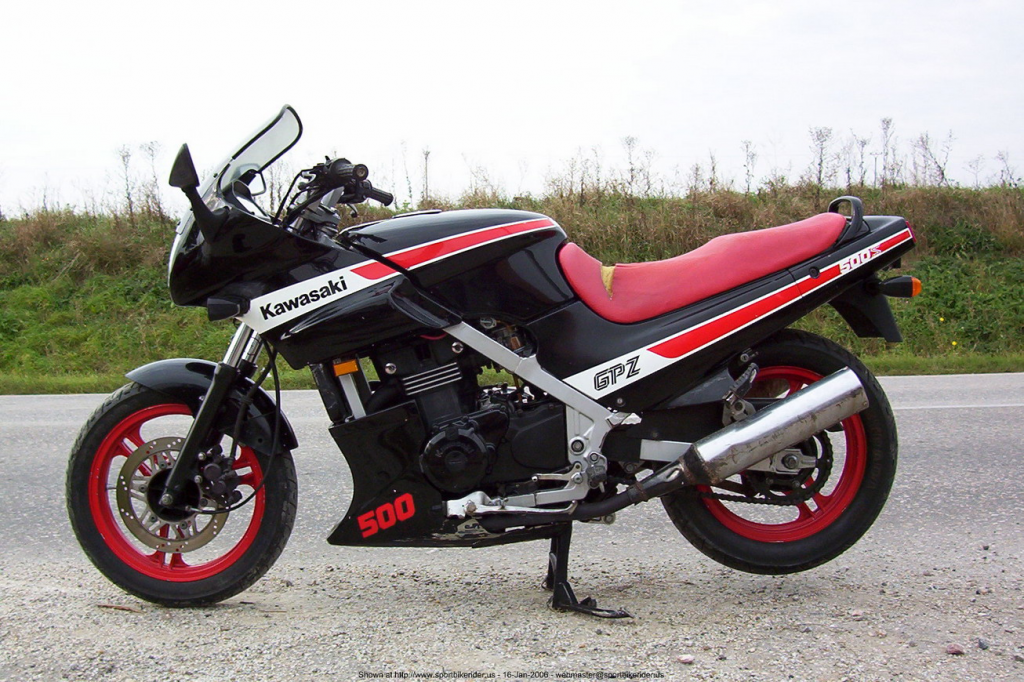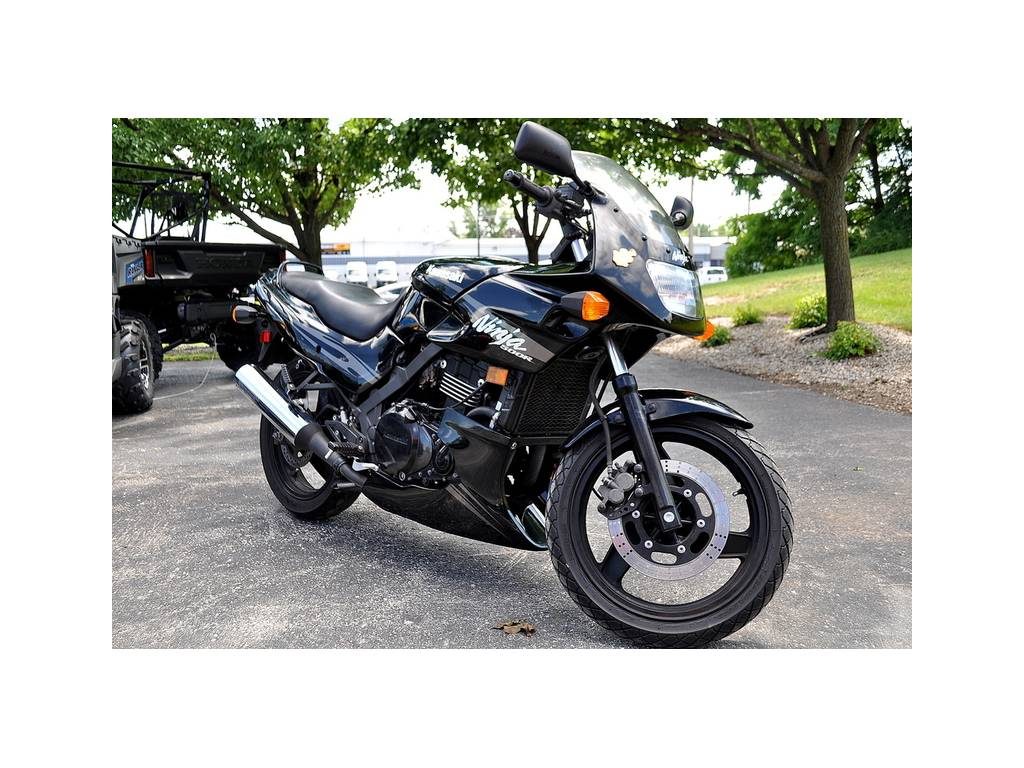That takes me back…
Recently while driving home I came across a sight that I never pass without stopping to offer help: a motorcyclist in distress due to some kind of mechanical failure.
There are two tell tale signs of this situation;
- Someone standing beside their bike on the side of the road –looking panicked– with their helmet lying on the ground about 4 feet behind the bike’s rear wheel. This is a popular signal bikers use to request assistance, although I only just recently came to know about it myself. If you encounter this scenario out on the road, please take the time to stop and ask if your brother or sister on two wheels needs a hand.
- The second sure sign is the one I came across on this particular day: a biker frantically pushing their bike in the inside lane with their hazard lights flashing.
This isn’t a good position for anyone that doesn’t want to end up embedded in the grill of a jacked-up Dodge pickup truck around these parts. Lucky for him traffic was light that evening (there must have been a rodeo, or NASCAR event going on?) and this rider managed to push the bike off the road and into a parking lot where I caught up to him.
The rider was a guy in his early twenties “riding” his newly acquired FIRST street bike. It just so happened to be a 1990’s era Kawasaki EX500.
He told me that he was still getting to know the bike and was confused about how it could be running perfectly for over an hour and then suddenly die and not want to start.
“Do you think you might just be out of gas?” I asked without trying to sound condescending.
“I can’t be. Listen to this.” He leaned the bike left and right quickly and I heard the swishing sound of gasoline in the tank moving around.
I smiled and realized he was about to have a crucial learning moment in his motorcycling career: learning the location of the fuel reserve on the gas tank petcock.
“This has happened to me before too and I was out of gas. Your fuel tank has a pickup tube that draws fuel from the tank in a way that it saves enough to drive another 20 kms or so after it runs out with the petcock valve in the “ON” position. All you have to do is turn this dial on the valve to the “RESERVE” notch and it’ll fire right up.”
“Pet-cock?”
“Yeah I know… it’s a stupid name for it.” I said as I pointed at the valve and he turned it to reserve.
The parallel twin engine roared back to life instantly after a twist of the throttle and a poke of the start button. He looked at me with a sheepish grin then was off to find a gas station.
1987 A Defining Year For Bikes
I was 12 when the first EX500 rolled off the Kawasaki assembly line. My 30 year obsession with motorcycles was also born that year and may be why 1987 stands out to me as significant.
It didn’t have much appeal to me at first because I was in love with the Honda Hurricane and Ninja 600 with their sexy full fairings, inline 4 engines, insanely high top speeds and low quarter mile times. It was the beginning of the really high performance 600cc sportbike obsession we enjoy today.
As great as those bikes were, I realized pretty quick that they weren’t good beginner bikes, but the EX500 was getting rave reviews from the many magazines I poured over when it came to newbie needs.
Specifications
The numbers and features of the 500 show exactly why it’s such an excellent beginner’s bike:
- light weight
- good power (but no radical powerband to deal with)
- low seat height and a semi upright seating position with an accommodatingly comfortable seat.
It’s also blessed with a low maintenance engine that’s easy to work on and only partial fairings that are inexpensive to replace when damaged.
The 6 speed transmission is very welcomed and why it’s at ease at highway speed while getting such impressive mileage.
Kawasaki has consistently worked to give buyers excellent performance at a low price. In other words, fast bikes that don’t cost an arm and a leg. The 500 can be purchased used for very reasonable amounts considering what you get in return. It’s a great bang-for-your-buck choice.
- 498cc Parallel Twin Liquid Cooled DOHC engine
- Twin Keihin CVK 34mm carburetor fuel delivery system
- 49 horsepower and 31 ft lbs of torque
- Power to weight ratio of 0.126
- 6 speed transmission
- 64 mpg fuel efficiency
- 30 inch seat height
- 388 lbs
Just About Perfect
Throwing around the word perfect can be irresponsible when describing anything, let alone a motorcycle for beginners.
Everyone is different in their ability to learn and command a two wheeled steed and so we have to look at bikes in a general sense with the understanding that “individual mileage may vary” so to speak.
Having said that the Ninja 500R, aka EX500, aka GPZ500 is about as close as you can get. It hits all the important criteria and highlights I recommend for learning. Not to mention it was ahead of its time when it comes to the recent trend of sport tuned parallel twin engines.
Really the only fly in the ointment for me is that it’s carbureted while newer bikes are fuel injected, but this isn’t a major factor whatsoever and shouldn’t drive anyone away.
Inverted front forks would also be nice to have along with ABS, but even 2018 comparables don’t have everything in order to keep things affordable.
2009: The End Of The Road
The bike was discontinued after 2009. It’s interesting that not long after that came the rise of very popular single and twin engined, lower displacement bikes on the market like the Yamaha R3, Honda CBR300 and 500 along with the KTM RC390.
Perhaps all the EX500 needed to carry on was an update better than the one it received in 1994 when the rear drum brake was changed to a disc? That year it also got the Ninja 500R moniker and some cosmetic improvements.
Common Modifications
Most everyone likes to tinker with their bikes. Typically installing a high flow air filter and some aftermarket exhaust to make some modest power gains. Go for it!
The 500 is tuned pretty aggressively right from factory so the power is where it should be, but many owners do find it runs too lean at low idle and rich everywhere else in the rpm range.
To counter this and smooth out the way the bike runs there is the FOG mod.
It involves drilling a third hole in the air box and adjusting the fuel mixture pilot screw. Not a challenging mod by any stretch and won’t strain your bike’s engine when completed. You may need to take the bike for a carb sync at a shop after the modification as most people don’t have the equipment to do it.
Here are the instructions for the Fog Mod.
Owner Complaints
There is no bike out there that won’t have at least some issues and the Ninja 500R is no different. The good news is that most of them are very minor complaints like the lack of a fuel filter. You can easily install one that is found on other Ninja bikes in minutes for low cost. This will help keep your carburetors clean longer.
Here is a nicely laid out list of gripes about the EX500 bikes.
http://www.ex-500.com/wiki/index.php?title=Common_Problems
Owner Reviews
Men and Motors made an excellent video review of the 1997 GPZ500 where we can see the semi-sport riding position clearly. The hosts thoroughly go over the bike and discuss in detail the pros and cons of ownership along with some buying tips. This one is well worth a look.
YouTuber Mdubrey put together a decent video of his 2009 Ninja focused at helping other new riders like him in getting to know the newest Ninja 500R available. We get a good walkaround of the bike along with discussion of pros and cons giving real owner insight. He does his own mechanical work and discusses how that’s gone along with sourcing replacement parts.
Final Thoughts
This is possibly the best choice for a confident beginner rider’s first bike. If you’re on a budget of only a couple of thousand dollars it’s a no brainer.
I said before though, that Kawasaki should have just updated the bike instead of discontinuing it in 2009 and it appears they may have heard me in a way considering what was just rolled out in the form of the 2018 Ninja 400.
It’s a bargain too and brand new! Very similar power numbers to the 500 but with all the enhancements I would have wanted on the 500 like fuel injection, better brakes with ABS and a lighter, stiffer Trellis frame for example.
If you have more money to spend I think I opting for the new 400 over the old 500 would be the best choice based on what I’ve seen so far… but that’s another story.





